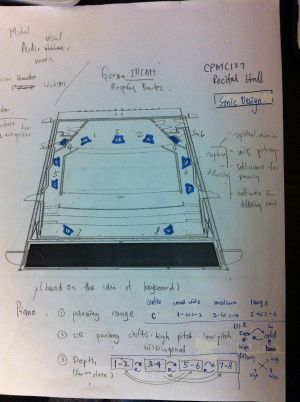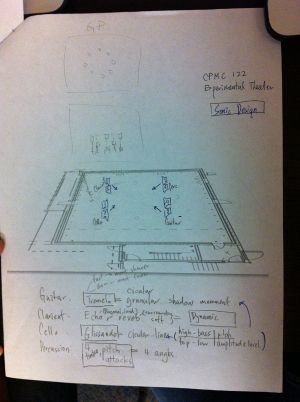Splash0119 (talk | contribs) |
Splash0119 (talk | contribs) |
||
| (20 intermediate revisions by the same user not shown) | |||
| Line 1: | Line 1: | ||
==Project | ==Project information== | ||
===Project title=== | |||
Fugue of Spaces | Fugue of Spaces | ||
| Line 8: | Line 9: | ||
==Project Theme== | ==Project Theme== | ||
# Virtual and physical presences | # Virtual and physical presences | ||
# Fusing and parting | # Fusing and parting | ||
# Shadow and object | # Shadow and object | ||
| Line 15: | Line 16: | ||
# Piano soloist performing in the Experimental Theater. | # Piano soloist performing in the Experimental Theater. | ||
# An accompanying instrumental quartet performing in the Recital hall. | # An accompanying instrumental quartet performing in the Recital hall. | ||
The instruments in the quartet are | ===The instruments in the quartet are=== | ||
* Clarinet | * Clarinet | ||
* Guitar | * Guitar | ||
| Line 29: | Line 30: | ||
==Sonic motives== | ==Sonic motives== | ||
# Linear direction [Recital Hall] & Circular motion [Experimental Theater] | # Linear direction [Recital Hall] & Circular motion [Experimental Theater] | ||
# Super Spatialization | # Super Spatialization | ||
* Expansion and distortion of spaces, merge two sonic spaces into one | |||
* Juxtaposing and integrating the two sonic motives | |||
3. Twelve sonic fields: (via reverb, delay, data transmission latency, etc)- to create sonic characters that are coherent but also having their own different individualities. | |||
==Visual motives== | ==Visual motives== | ||
| Line 39: | Line 40: | ||
==Musical structure, concept, and motive== | ==Musical structure, concept, and motive== | ||
# Twelve is the key number of the composition | |||
# A one hour-long composition with twelve short musical movements: | |||
Twelve pieces represent 12 months; 12 pitches, 12 characters (Chinese flowers and poems) | |||
3. An intermission is designed in the middle of the performance: | |||
* Audience from one of the performance venues will be asked to change to the other performance venue [ex. Recital hall to Theater, Theater to Recital Hall] | |||
4. Musical motive and structure (relevant to spatial motives and characters of the spaces): | |||
* Linear direction [for the pitch of the Piano solo, relevant to Recital Hall] | |||
* Circular motion [for the accompaniment, relevant to the Experimental Theater] | |||
==Explorations== | ==Explorations== | ||
# Aesthetic aspects: | |||
* Define sonic characters and identities of each space in order to create idiomatically composed dialogues between them. | |||
2. Create sonic motives and gestures specific to each space and integrate them into the composition musically. | |||
* Virtual presence, physical exchange, and telematic transcendence of the audience members | |||
3. Technical aspects: | |||
It is aimed to be composed idiomatically for telematic space, use it as a meaningful (inevitable) musical medium. | |||
* sonic spatiality | |||
* multi-dimensional/ immersive experience (performers' mind and sonic perceives) | |||
* latency in telematic signal transfer (sonic/ visual) | |||
==Musical idea and different version== | ==Musical idea and different version== | ||
Solo version | |||
Ensemble and concert version | |||
Telematic version | |||
Compare between productions of opera and opera in concert | Compare between productions of opera and opera in concert | ||
Laterncy, special musical practices of performance: | Laterncy, special musical practices of performance: | ||
- Passacaglia (or looping of a theme) with 12 different variations. Piano solo as the dominant role and other four accompanying instrument will be playing different heterophonic melodic texture that is based on the main theme that the piano play | |||
- Passacaglia (or looping of a theme) with 12 different variations. Piano solo as the dominant role and | |||
other four accompanying instrument will be playing different heterophonic melodic texture that is based on the main theme that the piano play | |||
==Ideas Drafting== | |||
[[File:Fugue of Spaces-1.JPG|left|thumb|Concert hall]][[File:Fugue of Spaces-2.JPG|left|thumb|Black box theater]] | |||
Latest revision as of 00:44, 13 May 2013
Project information
Project title
Fugue of Spaces
People
- Ideas by Yeung-ping Chen
- Jeffrey
- …anyone else who cares to be involved
Project Theme
- Virtual and physical presences
- Fusing and parting
- Shadow and object
Instrumentation
- Piano soloist performing in the Experimental Theater.
- An accompanying instrumental quartet performing in the Recital hall.
The instruments in the quartet are
- Clarinet
- Guitar
- Cello
- Percussion
Diagrams and stage design
-for the instrumental setting: and the two different spaces: (geometrical sonic and visual motives)
- Experimental Theater: Quadraphonic (circular) spatialzation =to project the presences of the four accompanists
- Recital Hall: Straight-line (panning between LH and RH) =to project the presence of the solo pianist
Sonic motives
- Linear direction [Recital Hall] & Circular motion [Experimental Theater]
- Super Spatialization
- Expansion and distortion of spaces, merge two sonic spaces into one
- Juxtaposing and integrating the two sonic motives
3. Twelve sonic fields: (via reverb, delay, data transmission latency, etc)- to create sonic characters that are coherent but also having their own different individualities.
Visual motives
- Use of projections with holographic screen to project the pianist (from the theater) image on the empty piano (in recital hall).
- Use of lighting/ projection (ex. four individual control projections that hanged on roof of the theater) to creates accompanying musician's shadows on the floor.
Musical structure, concept, and motive
- Twelve is the key number of the composition
- A one hour-long composition with twelve short musical movements:
Twelve pieces represent 12 months; 12 pitches, 12 characters (Chinese flowers and poems)
3. An intermission is designed in the middle of the performance:
- Audience from one of the performance venues will be asked to change to the other performance venue [ex. Recital hall to Theater, Theater to Recital Hall]
4. Musical motive and structure (relevant to spatial motives and characters of the spaces):
- Linear direction [for the pitch of the Piano solo, relevant to Recital Hall]
- Circular motion [for the accompaniment, relevant to the Experimental Theater]
Explorations
- Aesthetic aspects:
- Define sonic characters and identities of each space in order to create idiomatically composed dialogues between them.
2. Create sonic motives and gestures specific to each space and integrate them into the composition musically.
- Virtual presence, physical exchange, and telematic transcendence of the audience members
3. Technical aspects: It is aimed to be composed idiomatically for telematic space, use it as a meaningful (inevitable) musical medium.
- sonic spatiality
- multi-dimensional/ immersive experience (performers' mind and sonic perceives)
- latency in telematic signal transfer (sonic/ visual)
Musical idea and different version
Solo version
Ensemble and concert version
Telematic version
Compare between productions of opera and opera in concert
Laterncy, special musical practices of performance:
- Passacaglia (or looping of a theme) with 12 different variations. Piano solo as the dominant role and other four accompanying instrument will be playing different heterophonic melodic texture that is based on the main theme that the piano play

